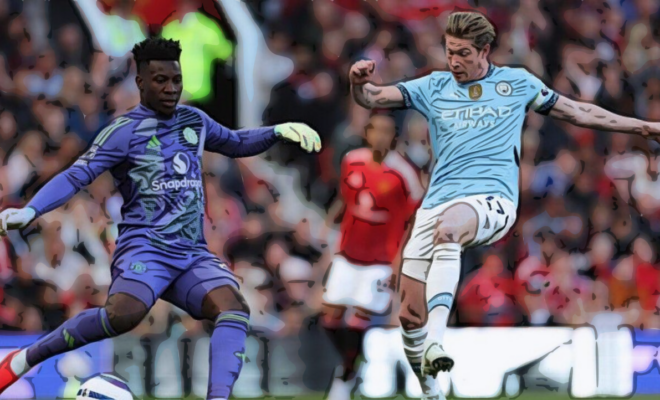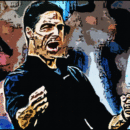Breaking the Block: What Arsenal Can Learn from City’s Frustration Against United’s Defense

The Premier League landscape is a constantly evolving tactical battleground, where the ability to adapt and overcome diverse defensive structures is a hallmark of any serious contender. The recent stalemate at Old Trafford between Manchester United and Manchester City served as a potent reminder of this reality. While many anticipated a City victory, crucial for their aspirations of securing a top-four finish, they found themselves blunted and ultimately held to a 0-0 draw by a resolute and deep-lying Manchester United defense. This encounter, devoid of the expected attacking fireworks from Pep Guardiola’s side, offers a compelling case study, particularly for teams like Arsenal who harbor ambitions of consistently challenging at the highest level and may encounter similar defensive walls. By meticulously dissecting City’s fruitless endeavors to breach United’s rearguard, Mikel Arteta’s Arsenal can glean invaluable lessons in how to dismantle stubborn, compact defenses and ensure their own attacking endeavors yield more consistent rewards.
The narrative preceding the derby suggested a Manchester City side eager to capitalize on slip-ups from their rivals in the race for UEFA Champions League qualification. However, they were met by a Manchester United team, potentially under the guidance of Ruben Amorim, that displayed impressive defensive organization and discipline. Ending a run of eight home league matches without a clean sheet, their longest such streak since 2021, United showcased a newfound solidity at the back, with Harry Maguire playing a significant role in anchoring the defense after replacing the injured Matthijs de Ligt. This defensive resilience formed the bedrock of their game plan, effectively stifling City’s renowned attacking prowess.
Manchester City, faced with this well-drilled unit, largely dominated possession, as is their customary approach. However, their patient build-up play often lacked the penetrative edge required to carve out clear-cut scoring opportunities. With Erling Haaland likely sidelined, Guardiola opted for a tactical variation, employing a midfield diamond formation with Kevin De Bruyne frequently positioned as the most advanced player, supported by the interchanging movements of Phil Foden, Omar Marmoush, and Ilkay Gundogan. Despite this creative configuration, City struggled to find consistent routes through or behind the compact United defense. Their passing sequences, while intricate at times, often unfolded in areas that posed little immediate threat, with penetrative runs into dangerous spaces proving conspicuously absent. It appeared that City were also acutely aware of United’s potential on the counter-attack, particularly the pace of Alejandro Garnacho, leading to a degree of caution that further hampered their attacking impetus.
Looking closer at the opportunities City did manage to create, a lack of decisiveness and execution proved costly. Phil Foden squandered a significant chance early in the second half, poking wide under pressure after taking in a flick from Marmoush. Ilkay Gundogan also dragged a hopeful attempt wide in the first half, contributing to City’s overall flat attacking display. These moments underscored a recurring theme: City’s inability to convert promising situations into genuine threats against a defense that, while organized, was not entirely impenetrable.
In contrast, Manchester United, while largely focused on their defensive structure, did carve out some notable opportunities, primarily through the lively Alejandro Garnacho and substitute Joshua Zirkzee. Garnacho was inches away from winning an early penalty and later failed to connect properly with an unmarked stooping header. In the latter stages, a Garnacho cutback found Zirkzee in the center of the penalty area, but Ederson produced a fine save to deny him a potential winner. These instances highlighted that even against a dominant possession side like City, well-executed counter-attacking moves and moments of individual brilliance can yield scoring chances.
For Arsenal, observing City’s struggles at Old Trafford offers crucial insights into the challenges of facing teams that adopt a deep and organized defensive block. While Arsenal possess their own array of creative talents and have demonstrated the capacity for intricate attacking play, they too have encountered frustrating afternoons against sides prioritizing defensive solidity. The derby illustrated that patient possession alone is often insufficient to unlock such defenses.
Drawing lessons from City’s frustrating experience, Arsenal can explore and refine alternative attacking strategies to ensure they can consistently break down stubborn rearguards:
- Exploiting Quick Transitions: Unlike City’s often methodical build-up, Arsenal could focus on capitalizing on turnovers in possession and launching rapid counter-attacks before the opposition defense has fully retreated and organized. The pace of players like Gabriel Martinelli and Bukayo Saka could be particularly effective in such scenarios. Manchester United themselves showed glimpses of this potential through Garnacho.
- Intricate Passing in Tight Spaces: While City struggled to find the final incisive pass, Arsenal’s creative midfielders, such as Martin Odegaard and Emile Smith Rowe, possess the vision and technical ability to navigate tight spaces and unlock defenses with clever combinations and through balls. This requires precise execution and coordinated movement from the attacking players.
- Utilizing the Width of the Pitch: City’s attacks often appeared narrow, allowing United to maintain a compact defensive shape. Arsenal could aim to stretch opposition defenses by fully utilizing the width of the pitch, with their full-backs providing overlapping runs and wingers hugging the touchlines. This can create more space in central areas for midfielders to operate and forwards to find openings.
- The Role of Individual Brilliance and Creative Movement: In games where structured attacks are stifled, moments of individual brilliance can be the key to breaking the deadlock. Arsenal possess players capable of such moments, whether it’s a mazy dribble, a powerful shot from distance, or an unexpected piece of skill. Encouraging and empowering these creative outlets, particularly in the final third, can be crucial.
- Effective Use of Set-Pieces: Against deep defenses, set-pieces can become vital opportunities to score. Arsenal need to maximize their threat from corners and free-kicks, both in terms of delivery and attacking movement in the box. Manchester United nearly benefited from a close-range set-piece early in the game.
The observations from the Manchester derby also underscore the importance of varying attacking approaches. Relying solely on patient possession, as City often did, can become predictable and easier for a well-organized defense to manage. Arsenal need to demonstrate tactical flexibility, capable of switching between quick transitions, intricate passing, and more direct attacking play depending on the game situation and the opposition’s defensive setup.
Furthermore, the match highlighted the need for clinical finishing when opportunities do arise. City’s missed chances, even half-chances, allowed United to remain in the game and ultimately secure a point. Arsenal must ensure their attacking players are consistently sharp and decisive in front of goal, maximizing their conversion rate to punish any defensive lapses or openings they manage to create.
While Fulham’s victory over Liverpool is not the direct focus of this analysis, it serves as a contrasting example of clinicality against a high-profile opponent. Fulham’s ability to capitalize on Liverpool’s defensive errors demonstrates the impact of ruthlessness in the final third, a quality Arsenal can strive to emulate, particularly when facing opportunities created against deep-lying defenses, even if those opportunities are infrequent.
Reflecting on the managerial perspective, while Guardiola’s direct assessment of the game focuses on City’s lack of penetration in the right areas against United’s narrow 5-4-1 formation and their awareness of United’s transitional threat, his comments implicitly acknowledge the difficulty of breaking down a deep block. This reinforces the need for alternative and more incisive attacking strategies.
In conclusion, the 0-0 draw between Manchester United and Manchester City was more than just a dropped two points for the visitors; it was a tactical exhibition of how a well-organized and deep defense can frustrate even the most potent attacking units. For Arsenal, the lessons from this derby are clear. Breaking down the block requires more than just possession; it demands a multifaceted attacking approach that incorporates quick transitions, intricate play in tight spaces, effective use of width, moments of individual brilliance, and, crucially, clinical finishing. By analyzing City’s struggles and proactively developing and implementing these alternative strategies, Arsenal can equip themselves to consistently unlock stubborn defenses and enhance their ability to secure vital victories in their pursuit of top honors. The stalemate at Old Trafford serves as a valuable blueprint – not for replication, but for learning and ultimately, for overcoming similar defensive challenges that lie ahead.


